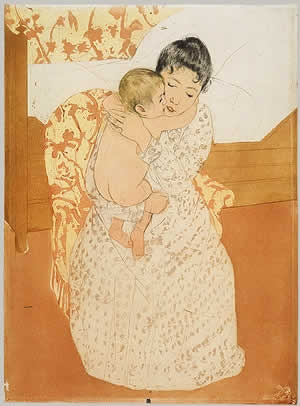Print genres:
19th century prints
What are 19th century prints?
19th century prints include lithography, wood engravings, engravings, etchings and photomechanical methods. 19th century printers were able to print more than in the 18th century, as their techniques became more streamlined. These prints were used for a variety of purposes, including: newspapers, magazines, journals and fine art prints. Prints by the Impressionists and Post-Impressionists are possibly the most remembered from the era.
What artists made 19th century prints?
A few Impressionist and Post-Impressionist printmakers include: Manet, Monet, Cézanne, Degas, Gauguin, Cassatt, Redon, Toulouse-Lautrec, Renoir, Seurat and van Gogh.

Maternal Caress, 1891, by Mary Cassatt (American, 1844–1926)
Gustave Doré is known as a master of wood engravings, while Barbizon School, is remembered for their etchings of landscapes. The Nabis, such as Pierre Bonnard, Maurice Denis and Edouard Vuillard, worked at the end of the 19th and into the early 20th century.
Are 19th century prints valuable?
Due to the popularity of 19th century prints, many artist editions were reproduced in the 20th century. Indicators such as the artist’s signature, the type of paper and the edition number, are signs that can help determine whether a print is an original or a reproduction. Many of the popular printers and publishers would use a blindstamp, an inkless impression, embossing the company’s name or logo on the print.
Original 19th century prints are the most valuable. Some reproductions approved during the artist’s lifetime or by the artist’s estate can also be quite valuable. Commemorative and limited edition reproductions hold some collector value.
